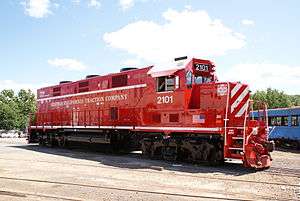Central California Traction Company
The Central California Traction Company (reporting mark CCT) is a Class III short-line railroad operating in the northern San Joaquin Valley, in San Joaquin County, California. It is owned jointly by the Union Pacific and BNSF Railway.
.png) | |
| Overview | |
|---|---|
| Parent company | Union Pacific BNSF Railway |
| Headquarters | Stockton, California |
| Reporting mark | CCT |
| Locale | San Joaquin Valley, California |
| Dates of operation | 1905– |
| Technical | |
| Track gauge | 4 ft 8 1⁄2 in (1,435 mm) standard gauge |
| Electrification | 1,200 V DC (former) |
| Length | 78 miles (126 km)[1] |
| Other | |
| Website | www |
CCT Interurban | ||||||||||||||||||||||||||||||||||||||||||||||||||||||||
|---|---|---|---|---|---|---|---|---|---|---|---|---|---|---|---|---|---|---|---|---|---|---|---|---|---|---|---|---|---|---|---|---|---|---|---|---|---|---|---|---|---|---|---|---|---|---|---|---|---|---|---|---|---|---|---|---|
| ||||||||||||||||||||||||||||||||||||||||||||||||||||||||
Service
The railroad operates between Stockton and Lodi. CCT also operates the Stockton Public Belt Railway around the Port of Stockton.
It connects to the Stockton Terminal and Eastern Railroad company freight lines that serve greater Stockton. Several miles of the CCT track through Acampo are being used to store rolling stock, primarily Centerbeam flatcars that carry lumber, as of 2009.

History
The Central California Traction Company was founded on August 7, 1905, as an alternative city streetcar line to the Stockton Electric Railroad. The company soon had greater ambitions and became a 1,200-volt DC electric interurban railway,[1] opening a line from Stockton to Lodi in 1907, and reaching Sacramento by 1910.
In 1928, the railroad was sold by the original owners and was then jointly purchased by the Atchison, Topeka and Santa Fe Railroad, the Southern Pacific Railroad and the Western Pacific Railroad.
The railroad operated over the same line from Lodi and Stockton to Sacramento until 1998, when service to Sacramento was suspended. Currently the tracks remain between Stockton and Sacramento, being kept for future operational options.
One of the Central California Traction Company train stations survives in Acampo, just north of Lodi. This station was converted to a residence, with interior walls and an expansion.
See also
- List of California Interurban Railroads
- Sacramento Northern Railway
- Stockton Terminal and Eastern Railroad
References
Notes
- Demoro, Harre W. (1986). California's Electric Railways. Glendale, California: Interurban Press. p. 202. ISBN 0-916374-74-2.
Bibliography
- Fickewirth, Alvin A. (1992). California railroads: an encyclopedia of cable car, common carrier, horsecar, industrial, interurban, logging, monorail, motor road, shortlines, streetcar, switching and terminal railroads in California (1851-1992). San Marino, CA.: Golden West Books. ISBN 0-87095-106-8.
- Hilton, George W.; Due, John F. (2000) [1960]. The Electric Interurban Railways in America. Stanford University Press. ISBN 0-8047-4014-3.
- Middleton, Wm. D. (2000) [1964]. The Interurban Era. Kalmbach Publishing Co. Milwaukee, WI. ISBN 978-0-89024-003-8.
- Robertson, Donald B. (1998). Encyclopedia of Western Railroad History - Volume IV - California. Caldwell, ID: The Caxton Printers. ISBN 0-87004-385-4.
- Stanley, David G.; Moreau, Jeffrey J. (2002). The Central California Traction Company. Lompoc, CA: Western Star Distributors. ISBN 1-930013-06-X.
- Stindt, Fred A. (1996). American Shortline Railway Guide - 5th Ed. Waukesha, WI: Kalmbach Publishing. ISBN 0-89024-290-9.
- Walker, Mike (1997). Steam Powered Video's Comprehensive Railroad Atlas of North America - California and Nevada - Post Merger Ed. Faversham, Kent, United Kingdom: Steam Powered Publishing. ISBN 1-874745-08-0.
External links
- Official Central California Traction Company−CCT website
- Comprehensive Trainweb.org: CCT Site
- Trainweb.org: Current CCT Locomotive Roster
- Cencalrails.railfan.net: Photographs of CCT
- Donsdepot.net: Photographs of CCT
- Western Pacific Railroad Museum — home of CCT Caboose #24.
- Tidewatersouthern.com: CCT Steeple Cab locomotive #100.
- Davesrailpix.com: Photograph collection of all interurbans — includes CCT and TS.
| Wikimedia Commons has media related to Central California Traction Company. |